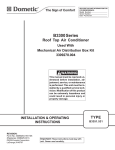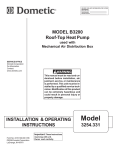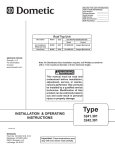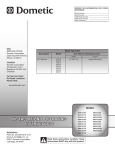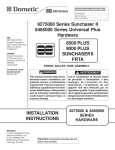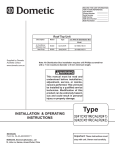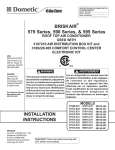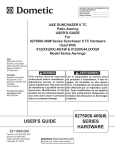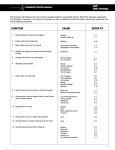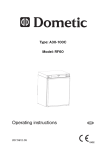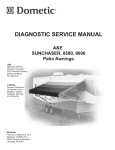Download Dometic B3351.533 Specifications
Transcript
SAFETY INSTRUCTIONS 1. GENERAL INFORMATION A. Product features or specifications as described or illustrated are subject to change without notice. The following are the basic requirements: 1. Installation opening. Cut through the roof and ceiling. 2. Additional Wiring. 220-240 VAC, 50 Hz. 10 Amp. 3. Power with the air conditioner on must be above 209 VAC and the frequency must be at 50 HZ. at all times. B. This Air Conditioner Is Designed For: This manual has safety information and instructions to help users eliminate or reduce the risk of accidents and injuries. RECOGNIZE SAFETY INFORMATION ! This is the safety-alert symbol. When you see this symbol in this manual, be alert to the potential for personal injury. C. Follow recommended precautions and safe operating instructions. UNDERSTAND SIGNAL WORDS A signal word , WARNING OR CAUTION is used with the safety-alert symbol. They give the level of risk for potential injury. ! WARNING indicates a potentially hazard- 1. Installation on a Caravan during the time the vehicle is manufactured. 2. Mounting on the roof of a Caravan. 3. Roof construction with rafters/joists on minimum of 40.6 cm centers. 4. Minimum of 5 cm and maximum of 10 cm distance between roof to ceiling of Caravan. The ability of the air conditioner to maintain the desired inside temperature depends on the heat gain of the Caravan. Some preventative measures taken by the occupants of the Caravan can reduce the heat gain and improve the performance of the air conditioner. During extremely high outdoor temperatures, the heat gain of the vehicle may be reduced by: 1. Parking the Caravan in a shaded area 2. Using window shades (blinds and/or curtains) 3. Keeping windows and doors shut or minimizing usage 4. Avoiding the use of heat producing appliances Operation on High Fan/Cooling mode will give optimum or maximum efficiency in high humidity or high outside temperatures. ous situation which, if not avoided, could result in death or serious injury. Starting the air conditioner early in the morning and giving it a "head start" on the expected high outdoor ambient will greatly improve its ability to maintain the desired indoor temperature. ! CAUTION indicates a potentially hazardous situation which, if not avoided, may result in minor or moderate injury. For a more permanent solution to high heat gain, accessories like Dometic A&E outdoor patio and window awnings will reduce heat gain by removing the direct sun. They also add a nice area to enjoy company during the cool of the evening. CAUTION used without the safety alert symbol indicates, a potentially hazardous situation which, if not avoided, may result in property damage. Read and follow all safety information and instructions. 2 FIG. 5A FIG. 7 Force While Moving 32.5 cm 75 cm 87 cm 1.5 cm Weight of A/C Plus Service Personnel 43 cm C. ROOF PREPARATIONS 43 cm The 35.5 cm x 35.5 cm opening is part of the return air system of the Air Conditioner and must be finished in accordance with any national or local codes. 1. Roof Vent Locations: a. Remove all screws that secure the vent to the roof and remove the vent from the opening. b. Remove all sealing compound from around the vent opening. c. Seal all screw holes and all roof seams with a quality all weather sealant. See FIG. 8. Type B3351.533 & B3351.534 Roof /Return Air Grill - Cross Section 35.5 cm Light FIG. 8 Remove Screws Prohibits Installation Remove Vent FIG. 6 Scrape Sealant Seal All Holes And Seams Cabinet - Prohibits Use d. The roof must be designed to support 60 Kg. when the Caravan is in motion. Normally a 90 Kg. static load design will meet this requirement. See FIG. 7. 2. d. If the opening is less than 35 cm x 35 cm, it must be enlarged. e. If the opening exceeds 36 cm x 36 cm, it will be necessary to install spacers. New Opening (installation other than vent opening) ! WARNING There may be electrical wiring between the roof and the ceiling. Disconnect 220 - 240 volt AC power cord and the positive (+) 12 volt DC terminal at the supply battery. Failure to follow this instruction may create a shock hazard causing death or severe personal injury. 5 a. If a roof vent opening will not be used a 35.5 cm x 35.5 cm opening must be cut through the roof and ceiling of the Caravan. This opening must be located between the roof reinforcing members. See FIG. 9. Do Not Remove Structure FIG. 9 Do Not Cut Electrical Wires FIG. 11 Cut Hole d. The opening created must be framed to provide adequate support and prevent air from being drawn from the roof cavity. Lumber 2 cm or more in thickness must be used. See FIG. 12. No Blockages 2 cm Depends On Structure 38 cm Min Wire Length At Front Of Opening Good FIG. 12 b. Mark a 35.5 cm x 35.5 cm square on the roof and carefully cut the opening. See. FIG. 10, 11 & 12. c. Using the roof opening as a guide, cut the matching hole in the ceiling. Frame Opening To Prevent Roof collapse When Unit Tightened Down CAUTION It is the responsibility of the installer of this air conditioner system to ensure structural integrity of the Caravan roof. Never create a low spot on the roof where water will collect. Water standing around the air conditioner may leak into the interior causing damage to the product and the Caravan. Remember to provide an entrance hole for power supplies, furnace wiring, and control cable. D. AIR DISTRIBUTION SYSTEM SIZING & DESIGN The Installer of this air conditioner system must design the air distribution system for their particular application. Several requirements for this system MUST be met for the air conditioner to operate properly. These requirements are as follows: 1. All discharge air ducts must be properly insulated to prevent condensation from forming on their surfaces or adjacent surfaces during operation of the air conditioner. This insulation must be R-7 minimum. 2. Ducts and their joints must be sealed to prevent condensation from forming on adjacent surfaces during operation of the air conditioner. 3. Return air openings must have 260 cm2 minimum free area including the filter. 4. Return air to the air conditioner must be filtered to prevent dirt accumulation on air conditioner cooling surface. FIG. 10 6 F. WIRING REQUIREMENTS 5 m Thermostat Connector Cable FIG. 15 Route a copper 1.5 mm2, with ground, 220 - 240 VAC supply line from the time delay fuse or circuit breaker box to the roof opening. a. This supply line must be located in the front portion of the 35.5 cm x 35.5 cm opening. b. The power MUST be on a separate 10 Amp time delay fuse or 10 Amp circuit breaker. c. Make sure that at least 38 cm of supply wire extends into the roof opening. This ensures an easy connection at the junction box. d. Wiring must comply with all National and Local Wiring Codes. e. Use a steel sleeve and a grommet or equivalent methods to protect the wire where it passes into the opening. 2. Route a dedicated 12 VDC supply line (0.50 mm2 to 0.75 mm2) from the Caravan's converter (filtered terminals) or battery to the roof opening. a. This supply line must be located in the front portion of the 35.5 cm x 35.5 cm opening. b. Make sure that at least 38 cm of supply wire extends into the roof opening. 3. If a furnace is to be controlled by the system, the two furnace thermostat leads must be routed to the roof opening. Make sure at least 38 cm of the furnace thermostat wires extend into the roof opening. 4. Route thermostat connector cable into the roof opening. Make sure 38 cm of cable extends into the roof opening, and 10 cm extends from the wall at the thermostat mounting location. See Section G-2. 1. Female End To Air Conditioner Male End To Thermostat b. Choose the shortest, direct route from the 35.5 cm x 35.5 cm opening to the thermostat location selected. c. Consider where screws, nails or staples might contact the cable. d. Leave approximately 10 cm of cable extending through the wall for connection to the thermostat. e. Leave approximately 35 cm of cable extending into the 35.5 cm x 35.5 cm opening for connection at unit. 3. Analog Thermostat Installation. a. Connect the Thermostat Connector Cable protruding from the wall onto the pre-wired thermostat connector cable. b. Gently push the two connectors together until a snap is heard and the lock on the male connector is latched on the female connector. c. Gently feed the connectors through the hole in the wall until the thermostat can mount flush. d. Remove the cover from the thermostat by starting at one corner and lifting it off the base. e. Mount the thermostat level on the wall using the screws provided in the locations shown in figure. 16. G. Analog Thermostat & Cable Installation 1. Analog Thermostat Location The proper location of the thermostat is very important to ensure that it will provide a comfortable Caravan temperature. Observe the following general rules when selecting a location: a. Locate the Analog Thermostat 140 cm above the floor. b. Install the Analog Thermostat on a partition, NEVER on an outside wall. c. NEVER expose it to direct heat from lamps, sun or other heat producing items. d. Avoid locations close to doors that lead outside, windows or adjoining outside walls. e. Avoid locations close to supply registers and the air from them. f. A 2.5 cm diameter hole will be needed to route the thermostat connector cable female end through the wall. See Section F-4. 2. Thermostat Connector Cable Installation. a. A Thermostat Connector Cable is provided to connect the air conditioner control box to the thermostat. The male end of this connector goes to the thermostat. The female end of the cable goes to the air conditioner. See FIG. 15. FIG. 16 HS +7.5 COOL FUR HI FAN GND HP FAN Screw Locations f. 8 Place the cover on the thermostat and push until and audible click is heard. f. Start each mounting bolt through the ceiling template and up into the unit base pan by hand. Install wood screw (not supplied) in each end of the ceiling template. This insures a tight fit of the return air cover to ceiling. See FIG. 22. c. Place divider plate up to bottom of air conditioner base pan firmly. The foam tape on the divider plate must seal to bottom of base pan. See FIG. 24. FIG. 24 Front of Vehicle Roof Gasket FIG. 22 Tighten to compress gasket to 13 mm or 4.5 5.0 NM Wood Screws Finger Tight d. With slight pressure then push the divider plate against the double sided tape on the ceiling template. Note: The adhesive on the insulation is extremely sticky. Be sure the part is located where desired before pressing into place. e. Locate the 18 cm x 45.5 cm self -adhesive insulation supplied with the return air kit. Remove the backing paper from the insulation and carefully stick onto the ceiling template divider panel. See FIG. 25. Tighten mounting bolts to compress gasket to 13 mm this will be a torque of 4.5 5.0 Nm. The bolts are self locking so over tightening is not necessary. See FIG. 22. 2. Installation of Divider Plate a. Measure the ceiling to roof thickness: • If distance is 5 - 9.5 cm, remove perforated tab from divider plate. • If distance is 9.6 - 14 cm, remove no tabs. b. Remove the backing paper from double sided tape located on ceiling template. See FIG. 23. FIG. 25 FIG. 23 • 5 - 9.5 cm CAUTION Improper installation and sealing of divider plate will cause the compressor to quick cycle on the cold control. This may result in fuse or circuit breaker opening and/or lack of cooling. f. 10 Excess width is intended to seal the divider plate to the sides of the 35.5 cm x 35.5 cm opening. This is to help prevent cold air discharge from circulating into the air conditioner return air opening. • If the insulation is too high, stick excess height of insulation to the air conditioner base pan. Do not cover up unit rating plate. Place the analog control box on the ceiling template with the white 6 pin connector plug on the side as shown in FIG. 26.













